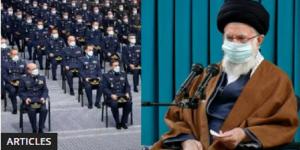(Video) IRAN: Khamenei’s media hypocrisy

In a speech to the commanders of the Iranian regime’s air force, regime supreme leader Ali Khamenei complained about dictatorship and censorship in foreign media and online platforms and called for a multipronged attack strategy.

Ironically, Khamenei’s regime has some of the strictest media censorship policies. Social media networks are banned in Iran. Television, radio, and other national media outlets are either owned or tightly controlled by the regime.

The state-run media censor news about protests, human rights abuses in prisons, fraud, and corruption at the highest levels of power, Covid-19 deaths, and economic problems caused by Khamenei’s policies. Instead, it paints a prosperous picture of the regime.

And in virtually every protest, the state broadcaster is the subject of scorn and ridicule of the protesters, who call it a “national shame.” Most Iranians get their news from social media, online websites, and satellite networks.
Iran has one of the worst records in suppressing freedom of expression, jailing, persecuting, and murdering journalists and cracking down on peaceful protests.
Khamenei claimed that Iran’s regime has been targeted with a “multifaceted attack from the enemy,” adding, “We can’t be on the defense forever.”
Khamenei stressed that the regime must go on the offense in different areas, including “media, security, and economy,” and called on regime officials to lead efforts in this regard. Khamenei was especially angry over his regime’s failure to control social media networks, which he described as “dictatorship.”
“You can’t bring up the name of martyr Soleimani because it will be removed,” Khamenei said, referring to the regime’s eliminated terror mastermind Qassem Soleimani. “They control the social media, and they can’t stand Soleimani’s name and picture.
Today, anything that is in opposition to western policies will be banned. And then they use these same spaces to amplify the problems of the Islamic Republic or to undermine Islam and Islamic values.”
Ironically, Khamenei’s regime has some of the strictest media censorship policies. Social media networks are banned in Iran. Television, radio, and other national media outlets are either owned or tightly controlled by the regime and only serve the regime’s propaganda policies.
The state-run media censor news about protests, human rights abuses in Iran’s prisons, fraud, and corruption at the highest levels of power, Covid-19 deaths, and economic problems caused by Khamenei’s policies. Instead, it tries to paint a prosperous and powerful picture of the Iranian regime.
Iran’s media has lost its credibility to the point that most polls show that very few people turn to regime-based outlets. And in virtually every protest, the state broadcaster is the subject of scorn and ridicule of the protesters, who call it a “national shame.” Most Iranians get their news from social media, online websites, and satellite networks.
Iran has one of the worst global records in suppressing freedom of expression, jailing, persecuting, and even murdering journalists, and cracking down on peaceful protests.
The regime has a bloody history of torturing and executing dissidents inside Iran and assassinating them abroad. In fact, what people read on social media and online websites is exactly the facts and news that the regime is trying to censor.
Khamenei has called for countering online and foreign media by investing in more propaganda and censorship. But the regime is already investing a large part of the government budget in its broadcasting and media apparatus.
Khamenei is afraid of the volatile state of society and is trying to lay the blame on anyone but himself. In reality, it is not the news on social media that prompts and encourages Iran’s people to come out onto the streets and hold protest rallies.
They are protesting because they have been deprived of their most basic rights and needs and have not received any answers to their many grievances.
They are faced with poverty, inflation, unemployment, lack of freedom, problems that are deeply ingrained in the regime’s ideology and structure. These problems will not go away by pouring more money into the propaganda and censorship apparatus, as continued protests across Iran show.
They will only be solved when the mullahs’ regime is replaced with a democratic state that cares for the well-being of the people and respects freedom of speech and media.
Shahin Gobadi
NCRI
+33 6 51 65 32 31
email us here
The most recent protests in Isfahan were indicative of the state of outrage across the country.
Legal Disclaimer:
EIN Presswire provides this news content "as is" without warranty of any kind. We do not accept any responsibility or liability for the accuracy, content, images, videos, licenses, completeness, legality, or reliability of the information contained in this article. If you have any complaints or copyright issues related to this article, kindly contact the author above.


